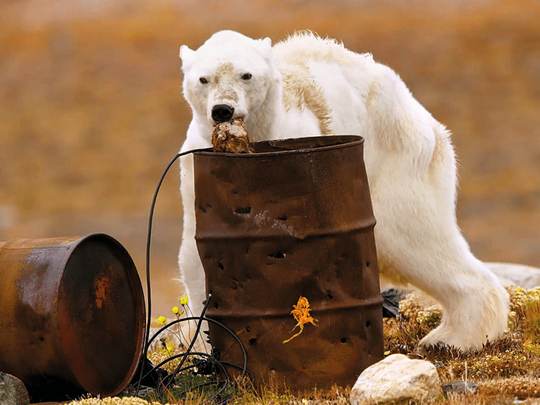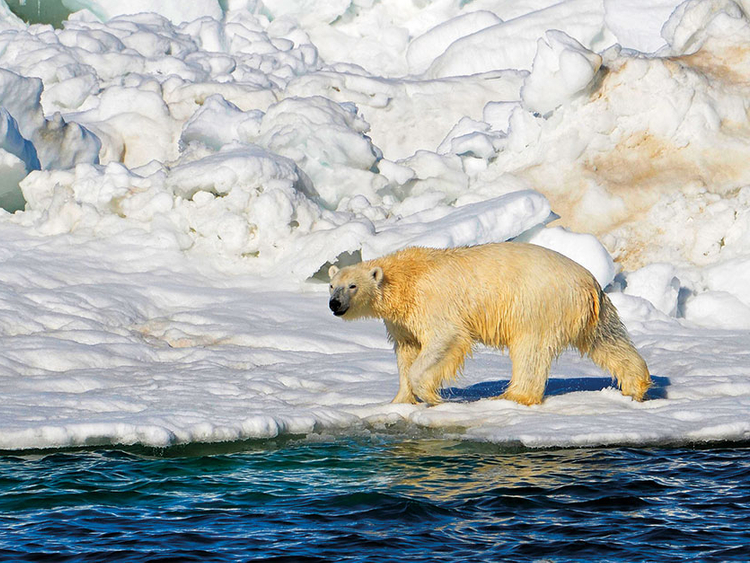
Ottawa: The world’s tragedies often have images that end up defining them: A five-year old screaming in Iraq after her parents were killed by US soldiers. A starving child being stalked by a vulture during a ruthless famine in Sudan.
A video released this week of an extremely emaciated polar bear has served as a similar purpose: as a rallying cry and stand-in for a largely unmitigated environmental disaster.
The video was shot by Paul Nicklen, a nature photographer and contributor to the National Geographic magazine for the last 17 years. He is also a biologist by training and the co-founder of Sea Legacy, a non-profit that uses storytelling and images to advocate for the environment.
Nicklen’s video, which he shot on a trip for Sea Legacy, depicts an emaciated polar bear, its coat patchy, seemingly near death on an island in a Canadian territory inside the Arctic Circle. It searches for food in a rusted garbage can and chews what Nicklen said was an old snowmobile seat.
Haunting scene
And it struck a nerve: it was viewed more than 3.5 million times in posts on Nicklen’s and National Geographic’s Instagram feeds, according to metrics on the photo sharing site, before picking up news coverage from around the world.
In his caption with the video, Nicklen wrote that his team was “pushing through their tears” while documenting the bear.
“It’s a soul-crushing scene that still haunts me, but I know we need to share both the beautiful and the heartbreaking if we are going to break down the walls of apathy,” he wrote. “This is what starvation looks like. The muscles atrophy. No energy. It’s a slow, painful death.”
The photo was shot on Somerset Island in the upper reaches of Canada. Nicklen and his team saw the bear and shot the video from about 400 feet away, he said. Nicklen, 49, who grew up in the region on nearby Baffin Island, said that he had never seen a bear in such poor condition before.
“We stood there crying — filming with tears rolling down our cheeks,” he told National Geographic.
He said that the intent behind the footage, which is set over a mournful soundtrack, was not purely journalistic. The trip he was on was part of a push to drive home the issue of climate change with Sea Legacy. Though he said that he had no definitive proof that the bear’s condition was connected to the global phenomenon, he said he wanted to show people what a starving bear looked like and let them draw their own conclusions.
Existential threat
“We are a visual species,” Nicklen said in a phone interview. “He should have been a dominant bear. Why he was dying, I don’t know.”
A shot of another emaciated polar bear taken by a photographer in 2015 raised similar questions.
Polar bears face an existential threat from climate change due to the loss of habitat from melting sea ice, scientists believe. The populations of some 25,000 polar bears in 19 locations worldwide are forecast to decline by as much as a third in the coming decades. As their hunting and breeding grounds shrink, polar bears face an increased threat of starvation.
More than any other animal, polar bears have become the poster animal for climate change, The Washington Post’s Cleve Wootson reported. Former Vice-President Al Gore used a cartoon of an exhausted, endlessly swimming polar bear to illustrate the impact humans were having on the sea ice where the bears once hunted. And studies and government agencies continue to warn that climate change could make polar bears extinct by 2050.
A paper, published in July, said that the higher global temperatures go the more likely polar bears are to interact with humans — and possibly attack and eat them.
Loss of icy habitats
Some expressed scepticism that anything could be gleaned about the environment from one image. A commenter on the National Geographic’s Facebook page wondered about the bear’s age, when the footage was taken and what an autopsy would show.
Dr Donald Moore, the director of Oregon Zoo, senior science adviser to Smithsonian National Zoo and expert on polar bears, said he couldn’t tell much more about the bear’s age or condition from the video except its extreme skinniness.
But he said that starvation was one of the results of the polar bear’s loss of icy habitats.
“These polar bears should be riding ice somewhere,” he said. “We have seen more and more very thin polar bears in the Arctic in recent years as climate change increases in intensity and opens up more water.”
He says that the population of about 25,000 polar bears in the wild has declined about 20 per cent over the last decade or so. Bears need an immense amount of food, he said, about an average of a seal a week.
Nicklen said that while most people were supportive of the photo, a small percentage had been offended that he had not taken more action: fed the bear or tried to save it. Or taken it out of its apparent misery.
“It’s not like we travel around with 200-300 of pounds of seal meat when we’re walking around in the Arctic,” Nicklen said. “We knew it was going to be gut wrenching and intense and horrible.”













